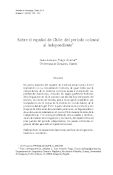Resultados: visualización detallada
Registro 1 de 1 para la búsqueda tipo de materia Comparaciones diacrónicas, cambios sociolingüísticos, tradición e innovación
Sobre el español de Chile: del período colonial al independiente
Juan Antonio Frago Gracia; Universidad de Zaragoza
Proyecto FFI2008-02718/FILO, MICINN
2010
-
Datos de edición
Boletín de Filología; Vol. 45, No. 1 (2010)
Universidad de Chile - Tipo de Documento Libro
-
Materia
Comparaciones diacrónicas, cambios sociolingüísticos, tradición e innovación
Diachronic comparisons, sociolinguistic changes, tradition and innovation -
Descripción
No pocos aspectos del español de América actual tienen difícilexplicación sin su consideración histórica, de igual modo que lainterpretación de la moderna sincronía ayuda a comprender susprecedentes diacrónicos, incluidos los rasgos grafémico - fonéticosde la lengua escrita. Es la cuestión que aborda la primera parte delartículo, con textos de Neruda, ...No pocos aspectos del español de América actual tienen difícilexplicación sin su consideración histórica, de igual modo que lainterpretación de la moderna sincronía ayuda a comprender susprecedentes diacrónicos, incluidos los rasgos grafémico - fonéticosde la lengua escrita. Es la cuestión que aborda la primera parte delartículo, con textos de Neruda, para a continuación establecer unacomparación con el corpus de la chilena sor Úrsula Suárez, de laprimera mitad del siglo XVIII. A partir de este corte sincrónico y conel apoyo de referencias documentales posteriores, se llega al análisisde un documento redactado en el mismo Chile durante los años de laIndependencia. Y se concluye señalando continuidades y cambios,varios de carácter sociolingüístico y normativo, del español coloniala las puertas del período independiente, con pautas evolutivas engeneral válidas para todo el español americano.Many aspects of the varieties of Spanish from Latin America can beexplained by considering their historic roots. In the same way, theinterpretation of modern synchrony helps to understand its diachronicprecedents, including the graphemic and phonetic features of thewritten language. The first part of the present article explores thisissue by focusing on texts by Neruda. Then it compares Neruda's textsto the corpus of the Chilean Úrsula ...Many aspects of the varieties of Spanish from Latin America can beexplained by considering their historic roots. In the same way, theinterpretation of modern synchrony helps to understand its diachronicprecedents, including the graphemic and phonetic features of thewritten language. The first part of the present article explores thisissue by focusing on texts by Neruda. Then it compares Neruda's textsto the corpus of the Chilean Úrsula Suárez, which draws from thefirst half of the 18th century. Starting from this synchronic snapshotand with the help of references from later documents, a text writtenin the same Chile during the years of the independence is analyzed.The analysis concludes by pointing out that there are both patternsthat continue as well as those that change. Several of these patternsare sociolinguistic and normative in nature in the colonial Spanishon the brink of the independent period. These evolutionary patternscan be applicable, in general, to all the varieties of Spanish fromLatin America.Facultad de Filosofía y Humanidades
- Identificador 44044






